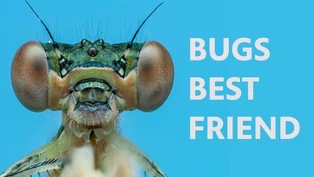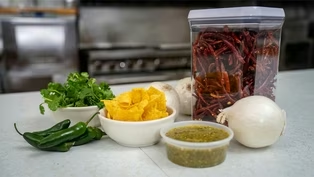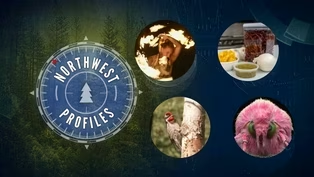Northwest Profiles
Birding in the Methow
Clip: Season 39 Episode 1 | 7m 40sVideo has Closed Captions
We follow along with a birding group that gives Seniors an introduction to Birding with sound.
If you’re a senior who is searching for something that gets you out of your recliner, follow along with us to the Methow Valley near Winthrop Washington as we meet up with a group from Methow At Home as they explore the world of birding!
Problems playing video? | Closed Captioning Feedback
Problems playing video? | Closed Captioning Feedback
Northwest Profiles is a local public television program presented by KSPS PBS
Funding for Northwest Profiles is provided by Idaho Central Credit Union, with additional funding from the Friends of KSPS.
Northwest Profiles
Birding in the Methow
Clip: Season 39 Episode 1 | 7m 40sVideo has Closed Captions
If you’re a senior who is searching for something that gets you out of your recliner, follow along with us to the Methow Valley near Winthrop Washington as we meet up with a group from Methow At Home as they explore the world of birding!
Problems playing video? | Closed Captioning Feedback
How to Watch Northwest Profiles
Northwest Profiles is available to stream on pbs.org and the free PBS App, available on iPhone, Apple TV, Android TV, Android smartphones, Amazon Fire TV, Amazon Fire Tablet, Roku, Samsung Smart TV, and Vizio.
Providing Support for PBS.org
Learn Moreabout PBS online sponsorshipThere's so many ways that you ca care of yourself, and some of them are to not keep doing th activity thats irritating you.
Sometimes time off just needs to off because we heal in our slee Next to her home in Carlton, Washington, In the Methow Valley, Robin Bair peruses a wide array of plants, taking stock of some of the bounty of herbs and berries that she grows and harvests for herself and her Phytotherapeutic In 2014 after a devastating fire Where her house and all of her Original plants were destroyed Robin rebuilt, and the process of regeneration is back.
It burned so hot that it took me several years to put the nutrients back in the ground.
As it's recovered, things are definitely coming back and itll never quite be what it was probably unless we have ten years of no drought.
With the help of irrigation, Robin has created a garden of sorts to grow some of her favorite medicinal plants.
This plant here is comfrey.
I get some nice, pretty leaves.
I use the leaves for sprains or wounds.
I dry the leaves some, and then I use them to make up, a general kind of wounds salve.
I also use the root Comfrey is abundant and spreads around, I can dig some up.
And the root has a lot of like mucilage in it.
So it really helps heal damaged tissue.
I'm a clinical herbalist here in the Methow Valley.
I've been doing this for oh, 30 plus years, kind of gradually moving it into more and more of a clinical practice.
what the herbs do is they kick your organs into functioning better instead of bypassing them.
Like using antibiotics long term.
Start to have detrimental effects on your digestion and all that.
So if you're taking those and I'll recommend things that support the things that they're hurting, but there's also other options to like keep your own system strong.
some people I work with don't want to have anything to do with standard medicine.
And some people are in that world and they're looking for something to help support it.
And what I do can do a lot towards supporting people through their digestive system, through how they react to inflammation, through a lot of the side effects of medication.
Having grown up in New York City, Robin at an early age took a shine to plants and developed an interest in Native American teachings of looking at medicine as being around you.
when I was in high school, I got more interested in how to be kind of independent, and some of that was learning how to grow your own food and recognize things as things that could take care of you.
And then in college, I studied botany and all that a little bit more.
then I actually went to school in Santa Fe in the early 90s, and, went to the National College of phytotherapy.
I got a lot more intensive kind of the science background, but also the materia medica, which is all the plant science.
As she wanders through her garden, we had the chance to find out what types of plants Robin grows and for what they're commonly used.
This is camomile.
And camomile is kind of one of my all time favorite plants because it's pretty much safe for everyone.
There's a few rare people that are allergic to things in this daisy plant family, this is a very mild but very potent medicine.
The flowers should have, like, a nice kind of bitter sweet, smell and flavor.
I like to pick it ideally when it's got a lot of petal on it.
I still have to order camomile because I use so much of it.
But sprinkling this in makes the formulas so much tastier especially for my teas, I do quite a few teas.
I love these guys This here is a young elderberry.
around it is Yarrow Yarrow is an amazing first aid remedy.
The leaves for like bee stings or like allergic reactions The flowers are also beneficial.
I use this in plants for the kidney bladder formulas.
It's a really good diuretic.
It helps for fevers And it is a pretty strong stiptic, to help stop bleeding.
this is calendula.
I love calendula.
I use a ton of it.
the petals are kind of sticky.
And those oils in there are really great for wound healing.
So this is Saint John's wort, this is sunshine.
This is one of those plants that they use for people who have seasonal affective disorder where like lack of sunshine.
the flowers and these leaves have this bright red oil.
And it's that almost like Burgundy color.
If I was doing something to help someone with mood to some extent with this plant, I might also throw in some lavender It has some bitter properties and those really kind of help with mood also.
And it smells good and it's pretty.
And there's something to be said for medicine that's pretty to look at.
Some things that we have here in abundance are like currants, whether you consider them edible is a matter of taste.
There's hawthorn berries which are really seedy, but they're amazing heart medicine.
elderberry and hawthorn flowers are really valuable.
and I make tincture out of the flower, and then a later Ill go and collect the berries because there's different, medicines and different parts of the plant.
the elderberries we have here, supports all your pathways, veins, arteries, Circulation.
some of the other thing with herbs is that people a lot of times just don't take nearly enough.
It's like a few drops of something won't necessarily do it because they don't see it in relationship to a medication they're taking, which is so powerful.
But you're just taking a little pill so you're not realizing in relationship...what you're taking.
I think one thing that's probably important to mention is just that there's a certain personal responsibility when you're doing alternative medicine to do some of the research yourself as with any over-the-counter medication, it's like you have to have some idea of what you're doing.
It's not safe just because it's on the shelf... for you.
Video has Closed Captions
Clip: S39 Ep1 | 7m 47s | Photographer Dara Ojo shares how a pandemic hobby turned into a passion seen around the world! (7m 47s)
Video has Closed Captions
Clip: S39 Ep1 | 5m 22s | In Spokane, Washington, a small troupe of fire dancers is lighting up the community — literally. (5m 22s)
Video has Closed Captions
Clip: S39 Ep1 | 4m 15s | Los Cinco Locos Salsa: How a Family Recipe from El Paso Became a Washington Favorite! (4m 15s)
Video has Closed Captions
Preview: S39 Ep1 | 30s | Fire Dancing, Los Cinco Locos Salsa, Insect Photographer, and Birding. (30s)
Providing Support for PBS.org
Learn Moreabout PBS online sponsorshipSupport for PBS provided by:
Northwest Profiles is a local public television program presented by KSPS PBS
Funding for Northwest Profiles is provided by Idaho Central Credit Union, with additional funding from the Friends of KSPS.


















